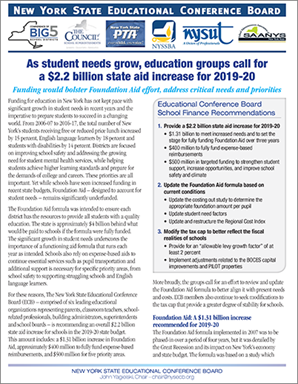For immediate release – December 6, 2018
Contact: ECB Chair John Yagielski, (518) 810-8382, chair@nysecb.org
Organizations cite double-digit increases in student need factors, importance of putting Foundation Aid back on track
Pointing to significant growth in student needs over the last decade, New York’s major statewide education organizations released a report today calling for a $2.2 billion state aid increase for 2019-20.
If enacted, the funding recommended by the Educational Conference Board (ECB) would enable schools to continue current programs and services for students and respond to an increase in student needs, which has occurred in all areas of the state and all types of school districts.
The paper points out that between 2006-07 and 2016-17, the total number of New York students receiving free and reduced price lunch increased by 15 percent; English language learners by 18 percent; and students with disabilities by 14 percent.
Meanwhile, the state is currently about $4 billion behind what is due to schools under the Foundation Aid formula enacted in 2007. The funding levels recommended by ECB would put the state on track to fully fund the formula within three years.
“The premise of Foundation Aid is that school districts will have the resources to meet student needs and provide them with a quality education,” said ECB Chair John Yagielski. “The changes in the last decade underscore the importance of a Foundation Aid formula that is funded and functioning in our state. Schools are charged with preparing students for a rapidly changing world and, with this paper, we have identified the state support that it will take to invest in their success.”
r
Click to download complete report (PDF)
There are three components to ECB’s state aid recommendations for 2019-20:
- A $1.31 billion increase in Foundation Aid, which is a third of what is due to schools. This would put the state on course to fully fund the formula in three years;
- A $400 million increase in expense-based reimbursements to continue essential programs and services such as student transportation and special education;
- A total of $500 million for five priority areas, including strengthening school safety, supporting struggling schools and English language learners and investing in college and career pathways.
ECB also outlined some longer-term recommendations to preserve and enhance the Foundation Aid formula, including updating the more than 15-year-old study that was the basis for the per pupil foundation amount.
ECB also recommends adjustments to the tax cap that would provide school districts and taxpayers with more stability, including providing for an allowable tax levy growth factor of at least 2 percent.
In the paper, ECB emphasized the importance of providing each district with a sufficient increase in state aid to keep pace with rising costs and escalating student needs, especially given that the tax cap limits the revenue that can be raised locally to support education.
“Absent the necessary resources, school leaders will increasingly have diminished ability to meet demonstrated needs while also continuing proven programs,” the paper states. “Enacting the recommendations in this paper would bridge the gap between current levels of funding and the programs and services that New York’s students need to be prepared for the future.”
-30-
The New York State Educational Conference Board is comprised the Conference of Big 5 School Districts; the New York State Council of School Superintendents; New York State PTA; New York State School Boards Association; New York State United Teachers; and the School Administrators Association of New York State.
